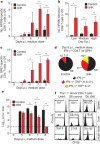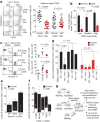Natural killer cells act as rheostats modulating antiviral T cells
- PMID: 22101430
- PMCID: PMC3539796
- DOI: 10.1038/nature10624
Natural killer cells act as rheostats modulating antiviral T cells
Abstract
Antiviral T cells are thought to regulate whether hepatitis C virus (HCV) and human immunodeficiency virus (HIV) infections result in viral control, asymptomatic persistence or severe disease, although the reasons for these different outcomes remain unclear. Recent genetic evidence, however, has indicated a correlation between certain natural killer (NK)-cell receptors and progression of both HIV and HCV infection, implying that NK cells have a role in these T-cell-associated diseases. Although direct NK-cell-mediated lysis of virus-infected cells may contribute to antiviral defence during some virus infections--especially murine cytomegalovirus (MCMV) infections in mice and perhaps HIV in humans--NK cells have also been suspected of having immunoregulatory functions. For instance, NK cells may indirectly regulate T-cell responses by lysing MCMV-infected antigen-presenting cells. In contrast to MCMV, lymphocytic choriomeningitis virus (LCMV) infection in mice seems to be resistant to any direct antiviral effects of NK cells. Here we examine the roles of NK cells in regulating T-cell-dependent viral persistence and immunopathology in mice infected with LCMV, an established model for HIV and HCV infections in humans. We describe a three-way interaction, whereby activated NK cells cytolytically eliminate activated CD4 T cells that affect CD8 T-cell function and exhaustion. At high virus doses, NK cells prevented fatal pathology while enabling T-cell exhaustion and viral persistence, but at medium doses NK cells paradoxically facilitated lethal T-cell-mediated pathology. Thus, NK cells can act as rheostats, regulating CD4 T-cell-mediated support for the antiviral CD8 T cells that control viral pathogenesis and persistence.
Conflict of interest statement
The authors declare no competing financial interests.
Figures




References
-
- Bukowski JF, Woda BA, Habu S, Okumura K, Welsh RM. Natural killer cell depletion enhances virus synthesis and virus-induced hepatitis in vivo. J. Immunol. 1983;131:1531–1538. - PubMed
Publication types
MeSH terms
Substances
Grants and funding
- R01 AI046578/AI/NIAID NIH HHS/United States
- AI-17672/AI/NIAID NIH HHS/United States
- AI07349/AI/NIAID NIH HHS/United States
- R37 AI017672/AI/NIAID NIH HHS/United States
- R01 DK052530/DK/NIDDK NIH HHS/United States
- T32 AI007349/AI/NIAID NIH HHS/United States
- DK52530/DK/NIDDK NIH HHS/United States
- R01 AI017672/AI/NIAID NIH HHS/United States
- R01 AI081675/AI/NIAID NIH HHS/United States
- R01 AR035506/AR/NIAMS NIH HHS/United States
- R01 CA034461/CA/NCI NIH HHS/United States
- AI-081675/AI/NIAID NIH HHS/United States
- AI46578/AI/NIAID NIH HHS/United States
- CA34461/CA/NCI NIH HHS/United States
LinkOut - more resources
Full Text Sources
Other Literature Sources
Molecular Biology Databases
Research Materials

